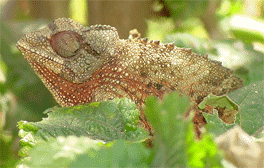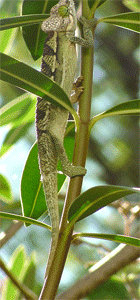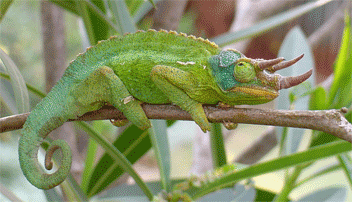 |
|
|
|
Chameleons are very unusual creatures, and in these pages we hope to explore and discover all there is to know about them. Chameleons are a type of lizard and therefore they are part of the reptile family of the animal kingdom. When you think about what you might already know about chameleons, it is probably something to do with the changing colour of it's skin. This is perhaps the most widely known fact about the chameleon; but when you look at the reasons why it changes colour, you might actually be surprised!
Reptiles are not able to regulate their own body temperature as they are 'cold blooded' and therefore have to rely on the ambient temperature, which is the temperature outside of their bodies (i.e. the air temperature), or the temperature of what they are laying on - like rocks that have warmed in the sun. There are many different species of chameleon, whose natural habitat is originally in Eastern Africa and Madagascar, which lie between the Equator and the Tropic of Cancer. Today chameleons are found in many other areas as they have been exported as pets and some have escaped forming local populations of chameleons.
Chameleons can live for as long as 10 years, and they can have between 8 - 50 young at a time. They are sufficiently developed at one year old to enter the reproductive cycle (Lifecycles). The micro habitat of chameleons is mainly in trees or bushes and they only go down to ground level to move from tree to tree when branches are not touching, or for some species, when laying eggs. Chameleons are usually solitary animals and prefer to live on their own. The only time they come together by choice is for mating. If two chameleons meet on a branch unexpectedly, they will usually 'fight', but they do not have defenses that can injure the other reptile and once the 'fight' is over, will go their separate ways.
|








